CONTROL THEORY
�
IEEE Press
445 Hoes Lane, P.O. Box 1331
Piscataway, NJ 08855-1331
IEEE Press Editorial Board
Robert J. Herrick, Editor in Chief
M.Akay
J. B. Anderson
P. M. Anderson
J. E. Brewer
M.Eden
M. E. El-Hawary
R. F. Hoyt
S. V. Kartalopoulos
D. Kirk
M.S.Newman
M. Padgett
W.D.Reeve
G. Zobrist
Kenneth Moore, DirectorofIEEE Press
Catherine Faduska, SeniorAcquisitions Editor
Robert H. Bedford, AssistantAcquisitions Editor
Anthony VenGraitis, ProjectEditor
Marilyn G. Catis, Marketing Manager
IEEE Control Systems Society, Sponsor
CSS Liaison to IEEE Press, Bruce M. Krogh
Cover design: William T. Donnelly, WT Design
Books of Related Interest from IEEE Press
PERSPECTWES IN CONTROL ENGINEERING: Technologies, Applications, and New Directions
Edited by Tariq Samad
2001 Hardcover
536 pp IEEE Order No. PC5798 ISBN 0-7803-5356-0
PHYSIOLOGICAL CONTROL SYSTEMS: Analysis,Simulation, and Estimation
A volume in the IEEE Press Book series on Biomedical Engineering
Michael C. K. Khoo
2000 Hardcover
344 pp IEEE Order No. PC5680 ISBN 0-7803-3408-6
THE CONTROL HANDBOOK
A CRC Handbook published in cooperation with IEEE Press
Edited by William S. Levine
1996 Hardcover
1566 pp IEEE Order No. PC5649 ISBN 0-8493-8570-9
ROBUSTVISIONFOR VISION-BASED CONTROL OF MOTION
A volume in the SPIE/IEEE Series on Imaging Science & Engineering
Edited by Markus Vincze and Gregory D. Hager
2000 Hardcover
264 pp IEEE Order No. PC5403 ISBN 0-7803-5378-1
�
CONTROL THEORY
Twenty-Five Seminal Papers (1932-1981)
Edited by
Tamer Basar
University ofIllinoisat Urbana-Champaign
Editorial Board
Brian D. O. Anderson
Karl J. Astrom
John Baillieul
TamerBasar (Chair)
Bruce A. Francis
Alberto Isidori
Petar V. Kokotovic
Huibert Kwakemaak
WilliamJ. Levine
Lennart Ljung
David Q. Mayne
Jan C. Willems
IEEE Control Systems Society,Sponsor
A Selected Reprint Volume
IEEE
PRESS
The Institute of Electrical and ElectronicsEngineers,Inc., New York
�
This book and other books may be purchased at a discount
from the publisher when ordered in bulk quantities. Contact:
IEEE Press Marketing
Attn: Special Sales
445 Hoes Lane, P.O. Box 1331
Piscataway, NJ 08855-1331
Fax: +1 732 981 9334
For more information on IEEE Press products, visit the
IEEE Online Catalog and Store: http://www.ieee.org/store.
© 2001 by the Institute of Electrical and Electronics Engineers, Inc.,
3 Park Avenue, 17th Floor, New York, NY 10016-5997.
All rights reserved. No part of this book may be reproduced in anyform,
nor may it be storedin a retrieval systemor transmitted in anyform,
withoutwrittenpermission from the publisher.
Printed in the United States of America.
10
9
8
7
6
5
4
3
2
1
ISBN 0-7803-6021-4
IEEE Order No. PC5870
Library of Congress Cataloging-in-Publication Data
Control theory:
em.
p.
twenty-five seminal papers (1931-1981) / edited by Tamer Basar,
"IEEE Control Systems Society, sponsor."
"A selected reprint volume."
ISBN 0-7803-6021-4
1. Automatic control.
2. Control theory.
Society.
TJ213.7.C662000
629.8--dc21
I. Basar,Tamer.
II. IEEE Control Systems
00-058171
CIP
�
Contents
Preface
vii
Regeneration Theory
Nyquist, H. (Bell Syst. Tech. J., Vol. 11, 1932, pp. 126-147.)
1
Stabilized Feedback Amplifiers
Black, H. S. (Bell Syst. Tech. J., Vol. 13, 1934, pp. 1-18.)
25
Relations Between Attenuation and Phase in Feedback Amplifier Design
Bode, H. W. (Bell Syst. Tech. J., Vol. 19,1940, pp. 421-454.)
45
The Linear Filter for a Single Time Series
Wiener, N. (Chapter III from Extrapolation, Interpolation, and Smoothing ofStationary Time Series,
81
The M.I.T. Press, Cambridge, MA, 1949, pp. 81-103.)
Control System Synthesis by Root Locus Method
Evans, W. R. (Trans. Amer. Inst. Electric.Engineers, Vol. 69, 1950, pp. 66-69.)
107
The Structure of Dynamic Programming Processes
Bellman, R. (Chapter 3 from DynamicProgramming, Princeton University Press, Princeton, NJ,
113
1957, pp. 81-89.)
Optimal Regulation Processes
Pontryagin, L. S. (Uspekhi Mat. Nauk, USSR, Vol. 14,1959, pp. 3-20. (English translation: Amer.
125
Math. Society Trans., Series 2, Vol. 18, 1961, pp. 321-339.»
Contributions to the Theory of Optimal Control
Kalman, R. E. (Bol. Soc. Mat. Mexicana, Vol. 5,1960, pp. 102-119.)
147
A NewApproach to Linear Filtering and Prediction Problems
Kalman, R. E. [Trans. ASME (J. Basic Engineering), Vol. 82D, March 1960, pp. 35-45.]
167
Dual Control Theory, Parts I and II
Feldbaum, A. A. [Automation and Remote Control, Vol. 21, April 1961, pp. 874-880, and May 1961,
181
pp. 1033-1039. (Russian originals dated September 1960, pp. 1240-1249, and November 1960,
pp. 1453-1464.)]
Absolute Stability of Nonlinear Systems of Automatic Control
Popov, V. M. [Automation and Remote Control, Vol. 22, February 1962, pp. 857-875. (Russian original
197
dated August 1961, pp. 961-979.)]
A Steepest-AscentMethod for Solving Optimum Programming Problems
Bryson, A. E., and Denham, W. F. [Trans. ASME (J. Appl. Mechanics), June 1962, pp. 247-257.]
219
v
�
vi
CONTENTS
The Solution of Certain Matrix Inequalities in Automatic Control Theory
Yakubovich, V. A. (DANDokladyAkademiiNauk SSSR),Vol. 143, 1962, pp. 1304-1307. (English
233
translation: SovietMathematics (by AmericanMath. Society), 1962, pp. 620-623.)
Mathematical Description of Linear Dynamical Systems
Kalman, R. E. (SIAMJ. Control, Vol. 1, 1963, pp. 152-192.)
239
On the Input-Output Stability of Time-Varying Nonlinear Feedback Systems-Part I: Conditions derived using
concepts of loop gain, conicity, and positivity; Part II: Conditions involving circles in the frequency plane
and sector nonlinearities
283
Zames, G. (IEEETrans. Automat. Contr., Vol. AC-ll, 1966, pp. 228-238 and 465-476.)
An Invariance Principle in the Theory of Stability
Lasalle, J. P. (in Differential Equations and Dynamical Systems, J. Hale and J. P. LaSalle, Eds.,
309
Academic Press, New York, 1967, pp. 277-286.)
Decoupling and Pole Assignment in Linear Multivariable Systems: A Geometric Approach
Wonham, W. M., and Morse, A. S. (SIAMJ. Control, Vol. 8,1970, pp. 1-18.)
321
System Theory on Group Manifolds and Coset Spaces
Brockett, R. W. (SIAMJ. Control, Vol. 10, 1972, pp. 265-284.)
341
Controllability of Nonlinear Systems
Sussmann, H. J., and Jurdjevic, V. (J. Diff. Eqns., Vol. 12, 1972, pp. 95-116.)
363
Dissipative Dynamical Systems-Part I: General Theory
Willems, J. C. (Arch. Ratl. Mech. and Analysis,Vol. 45, 1972, pp. 321-351.)
389
On Self-Tuning Regulators
Astrom, K. J., and Wittenmark, B. (Automatica, Vol. 9,1973, pp. 185-199.)
423
Nonlinear Controllability and Observability
Hermann, R., and Krener, A. J. (IEEETrans. Automat. Contr., Vol. AC-22, 1977, pp. 728-740.)
441
Analysis of Recursive Stochastic Algorithms
Ljung, L. (IEEETrans. Automat. Contr., Vol. AC-22, 1977, pp. 551-575.)
457
Discrete Time Multivariable Adaptive Control
Goodwin, G. C., Ramadge, P. J., and Caines, P. E. (IEEETrans. Automat. Contr., Vol. AC-25, 1980,
485
pp.449-456.)
Feedback and Optimal Sensitivity: Model Reference Transformations, Multiplicative Seminorms,
and Approximate Inverses
495
Zames, G. (IEEETrans. Automat. Contr., Vol. AC-26, 1981, pp. 301-320.)
Index
517
About the Editor
523
�
Preface
CONTROL is in one sense a fairly young discipline. Even though
it would be possible to push its historical origins back by about
two millennia to the days of the Babylonians, in modem terms
the real creation of the field has been in the twentieth century.
It is in this century that CONTROL became a scientificdiscipline,
with an intellectual core shaped by revolutionary ideas, novel
concepts, and a wealth of analytical and computational tools.
As a young and intellectually stimulatingdiscipline, it attracted
someof thebrightestmindsto itsranksand,withitstheorydriven
by real applications, it provided versatile tools for generations
of practicing engineers.
Prior to the twentieth century, there were of course also sev-
eral key contributions. Perhaps the firsttime the study of control
systemsattracted serious scientificattention was towardthe end
of the eighteenth century, following James Watts's invention
of the governor in 1788, which was designed to regulate the
speed of the rotary steam engine. A related work on governors
by Huygens! actuallypredated that of Wattsby about a century;
Huygensinventedthe centrifugalgovernoras a meansof regulat-
ing a clock, which was adapted for windmills and water wheels
in the Netherlandsas early as the seventeenthcentury.Feedback
played an important role in all these inventions,and soon it was
realized and widely acknowledged that it is a concept that lies
at the foundation of any successful control design. However, to
make effective use of feedback, there was a need for a careful
mathematicalstudy of its impact on control design.James Clerk
Maxwell was the first to realize this need and to respond to it by
developingin his now famous paperv'consideredby many to be
the starting point of the scientific approach to control research,
mathematicalmodelsfor variousgovernormechanismsbasedon
linear differentialequations. He worked out in his paper a com-
pletetheoryof stabilityfor constantcoefficientlineardifferential
equations up to fourth order, and obtained some conditions for
stabilityof fifth-order systems.Around the same time, and inde-
pendently of Maxwell,a Russian engineer,Vyshnegradskii, had
recognized the importance of control in industrial applications,
IC. Huygens, "Horologii oscillatorii," Part 5, Paris, 1673.
2J.C. Maxwell, "Ongovemors," Proc.RoyalSoc.London,16, 1868,pp. 270-
283.
and the need for developing a sound theory.' Where Maxwell
left off was then picked up by Edward John Routh," and inde-
pendently by Adolf Hurwitz.l who came up with what is known
todayas theRouth-Hurwitz stabilitycriteria,solvingcompletely
the problem of stability of constant coefficient linear differen-
tial equations of any finite order. At about the same time, and
as the nineteenth century was coming to a close, another trend-
settingdevelopmenttook place, again in the area of stability, but
this time for nonlinear dynamical systems. Motivatedby prob-
lems that arise in astronomy in connection with the motion of
the planets, a topic studied earlier by Henry Poincare," among
others,AleksandrMikhailovichLyapunovdevelopedin his doc-
toral thesis in Russia a new approach for testing the stability of
the equilibrium of a system described by nonlinear ordinary
differential equations, known today as the Second Method of
Lyapunov.
Hence, there was quite a bit of accumulatedactivityin control
at the beginning of the twentieth century. But what this century,
and particularly its secondhalf, deliveredwas somethingdiffer-
ent in terms of both content and sheer volume of diverse con-
tributions.The incessant growth caused by an explosion of new
fresh ideas, and drivenby numerous applicationsfrom different
domains, brought this activity to unprecedented levels. As we
are coming to the close of this century,we thought that it would
be useful to reflect back and ask the questions: What have been
the major results of this century in control? What have been the
greatest hits in control? How has control theory evolved since
the times of Maxwell, Routh, Hurwitz, and Lyapunov (among
others)?There is of course no unique way of answeringall these
questions, but one possible way is to collect under one cover,
3J. Vyshnegradskii, "Sur la theorie generale des regulateurs (On the general
theory of control)," Compt. Rend. Acad. Sci. Paris, 83,1876, pp. 318-321.
4E.J. Routh, A Treatise on theStabilityofa GivenStateofMotion,Macmillan
(London), 1877.
5A. Hurwitz, "Uber the Bedingungen unter welschen eine Gleichung nur
Wurzeln mit negativen reelen Teilen besitzt (On the conditions under which an
equation has only roots with negative real parts)," Mathematische Annalen,46,
1895, pp. 273-284.
6H. Poincare, Les MethodesNouvellesde la Mechanique Celeste (The New
Methods of the Cellestial Mechanics), Vol. 1, Gauthier-Villars (Paris), 1892.
vii
�
viii
PREFACE
and as a representative of the major research developments and
accomplishments in control in this century, some key papers that
have made major impact on the field, along with some introduc-
tory material for each.
These considerations have led to the present volume, which
contains twenty-five carefully selected seminal papers covering
the period 1932-1981, and begins with Harry Nyquist's famous
"Regeneration Theory" paper, which introduced the so-called
Nyquist criterion (still a versatile tool for control engineers) and
laid the foundations of a frequency-domain approach to stabil-
ity analysis of linear control systems. The volume ends with the
1981 paper by George Zames, which marks the beginning of
the "robustness" era in control-an era that we are leaving to
the coming generations to evaluate (perhaps by the middle of the
twenty-first century), along with other exciting developments the
control field has experienced for the past two decades, and will
undoubtedly continue to do so in the next century.
This volume was prepared under the auspices of the IEEE
Control Systems Society, by an Editorial Board consisting of
twelve members, namely:
Brian D.O. Anderson, Karl J. Astrom, John Baillieul, Tamer
Basar (Chair), Bruce A. Francis, Alberto Isidori, Petar ~
Kokotovic, Huibert Kwakernaak, William J. Levine, Lennart
Ljung, David Q. Mayne, and Jan C. Willems.
Based on nominations received in response to solicitations that
appeared in the IEEE Control Systems Magazine, and in the
E-LETTER on Systems, Control, and Signal Processing (based
in the Netherlands), and nominations generated by the Board
members, and after several rounds of voting, the Board unan-
imously agreed on the selection of the twenty-five papers in-
cluded in this volume. The preambles to each paper were written
by the Board members (in some cases jointly), with the primary
author(s) in each case identified by his (their) initials.
The twenty-five papers included in this volume cover a broad
spectrum of major developments in control theory in the twen-
tieth century, but still the volume should not be viewed as pro-
viding an exhaustive coverage of all topical areas of control, as
this has not been a criterion set by the Editorial Board in their
selection of the papers. The focus here has been the papers
selected rather than the areas of research in control. Still, we be-
lieve that the selected papers clearly outline the path which the
control discipline has followed during its rapid growth from the
1930s through the 1980s. To help the reader in this journey, in
the preambles to individual papers we have discussed develop-
ments in areas neighboring the topic of a particular paper, so as
to place its contributions and impact in proper perspective, and to
maintain continuity in the flow of ideas from one topic to another.
What is the path we can trace from the chronologically or-
dered papers in the volume? First comes the basic feedback the-
ory, as represented by the first three papers, by Nyquist, Black,
and Bode, which was the outcome of research conducted at
the Bell Laboratories in the 1930s driven by the need to de-
velop electronic feedback amplifiers for long telephone lines.
To this was added later, as a practical tool, the root locus method
of Evans. In the 1940s, Wiener's work on prediction, filtering,
and smoothing for time series, impacted control in many ways,
fostering further developments not only in filtering theory but
also in control design. The "Sputnik effect" and the ensuing
space research propelled the development of a mathematically
advanced optimal control theory in the late 1950s and early
1960s, with dynamic programming, maximum principle, and
the LQ regulator design (with its associated concepts of con-
trollability and observability) as its centerpieces, as represented
in the works of Bellman, Pontryagin, and Kalman included in
this volume. Also developed during this period were compu-
tational techniques to make dynamic programming and maxi-
mum principle practicable, as represented by the paper of Bryson
and Denham. During the same period, efforts were intensified
to develop an applicable stability theory of nonlinear feedback
systems in the absolute stability framework, represented by the
papers of Popov, Yakubovich, and Zames and, as extensions and
refinements of Lyapunov concepts, in the papers by LaSalle and
Willems. The need to operate in the presence of noise and other
disturbances was also recognized in the early 1960s, as shown in
papers by Kalman and Feldbaum. Then came the establishment
of the precise relationship between input-output descriptions and
state-space representations of linear systems, with its multifold
ramifications, as presented in the 1963 paper by Kalman, and
the establishment of a geometric theory for linear systems, in the
paper by Wonham and Morse, with the introduction of the novel
concept of controlled invariance, which found applications in
much broader domains (than linear systems) later. We see in
the 1970s the emergence of a nonlinear system theory, with as-
sociated richer concepts of controllability and observability, as
shown in the papers by Brockett, Sussmann and Jurdjevic, and
Hermann and Krener. Adaptive control is another area where a
comprehensive theory started emerging in the 1970s, where the
important notion of "self-tuning" was introduced (in the paper
by Astrom and Wittenmark), and methodologies were developed
for establishing the convergence of adaptive control algorithms,
as well as recursive stochastic algorithms, as presented in the
papers by Goodwin, Ramadge and Caines, and Ljung. Robust
control is yet another topic that gained steam in the late 1970s,
with the 1981 paper by Zames (the last paper in this volume)
marking the beginning of some intense activity in this domain.
Of course, there were many other accomplishments in control
during this period, than those represented by the twenty-five pa-
pers selected, and it is hoped that the preambles to the papers
will convey to the reader this richness in the field.
I hope that the reader will enjoy this journey, and will de-
velop a real sense of the evolution of the control field during
the fifty-year period, 1932-1981, through the milestone accom-
plishments embodied in these twenty-five seminal papers and
further discussed in the introductory material provided by our
Editorial Board. It is our hope that the volume will be a valu-
able resource in the twenty-first century (and beyond) especially
for young control researchers and engineers, and will be instru-
mental in the realization of an even more explosive century for
control theory and its applications.
Tamer Basar
University ofIllinois at Urbana-Champaign
�
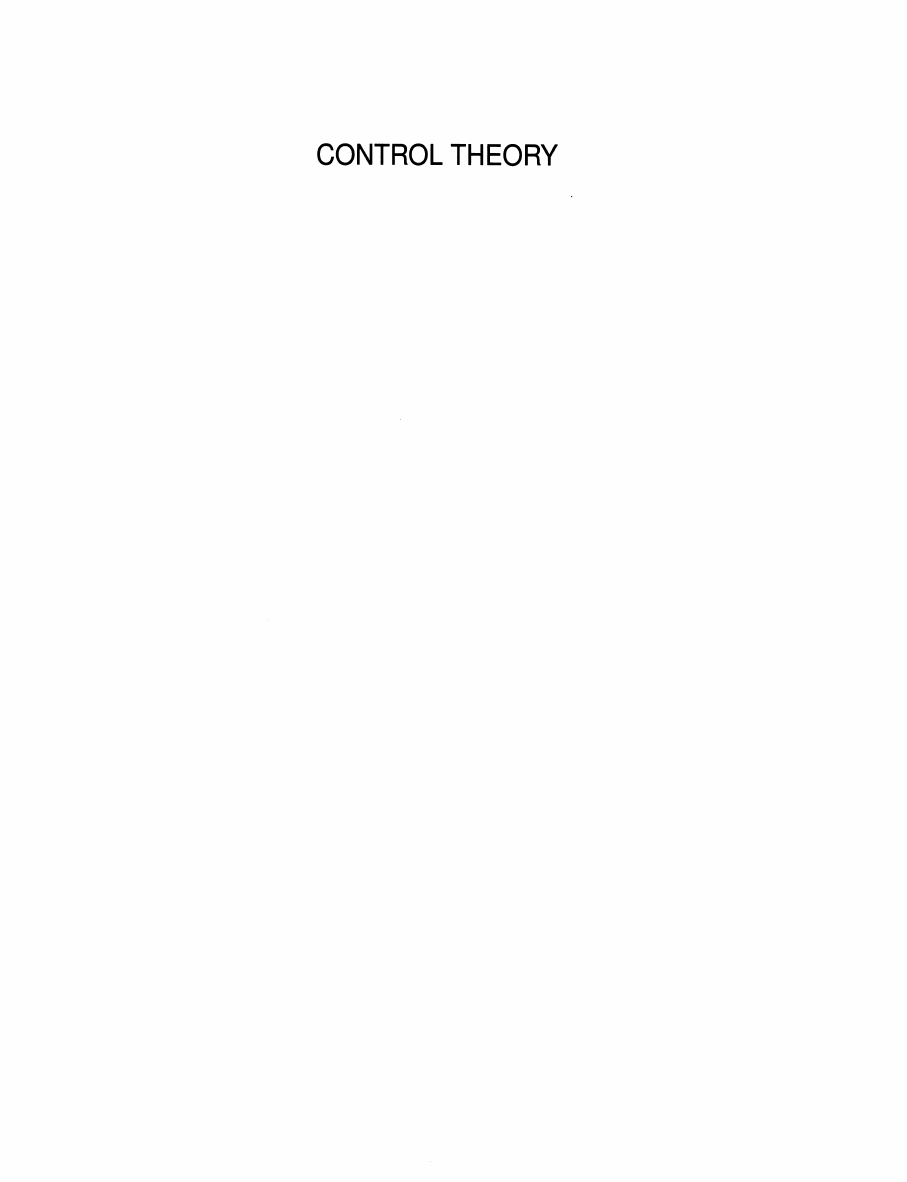

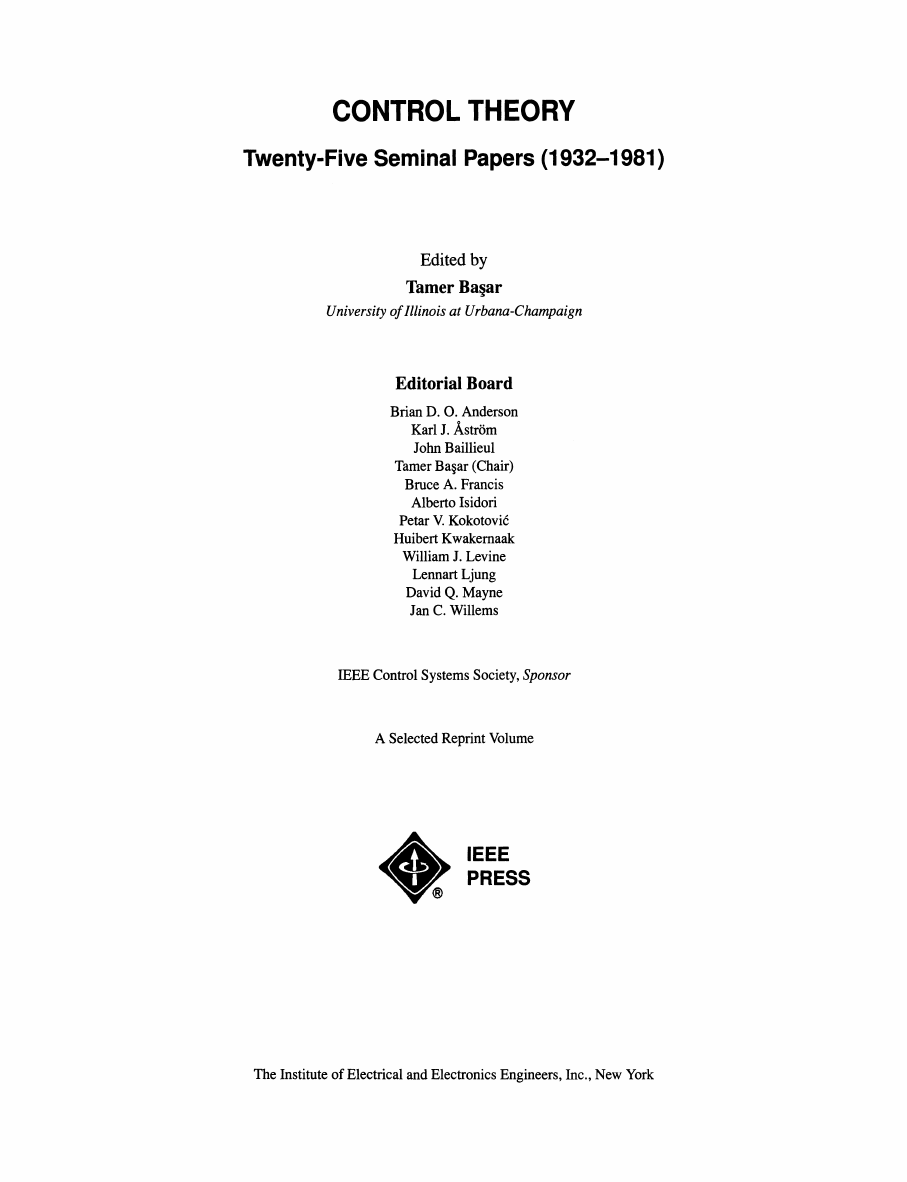
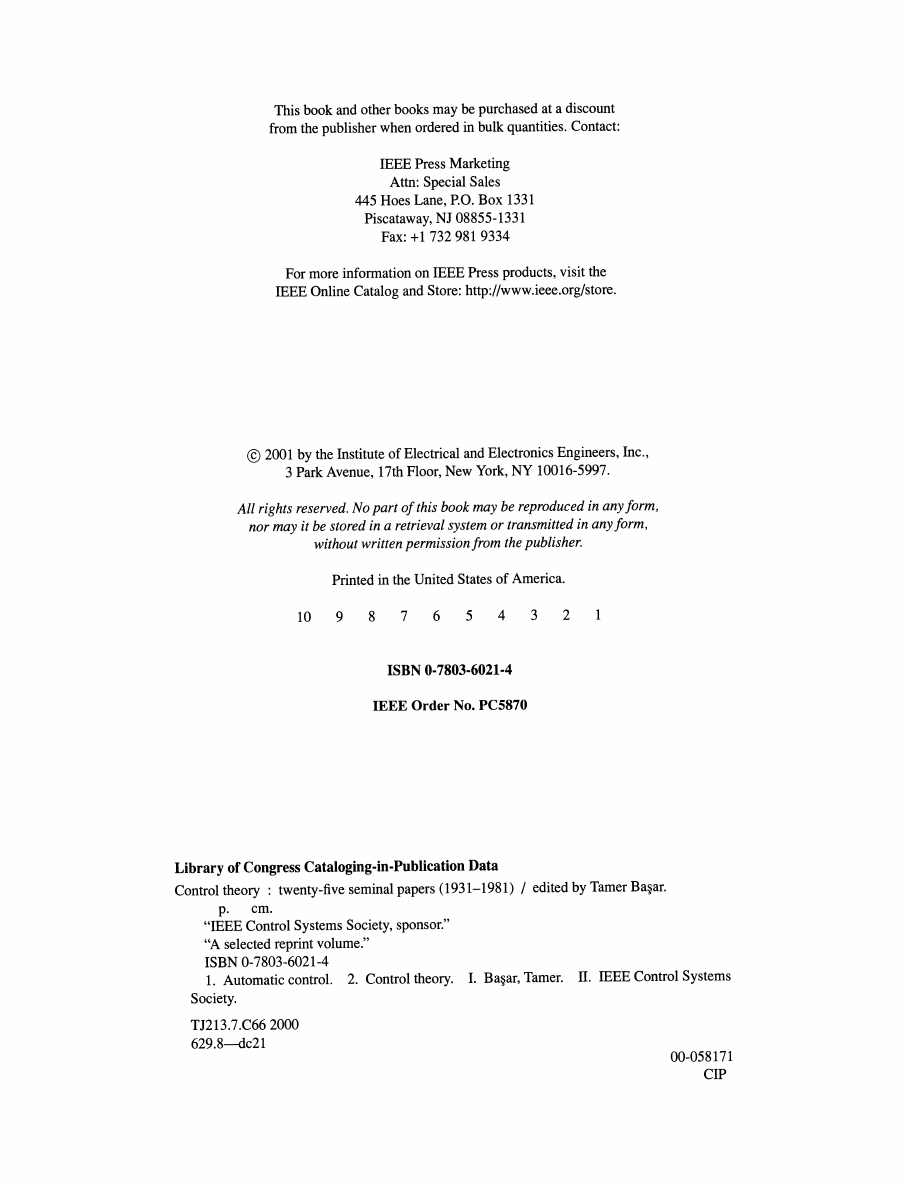
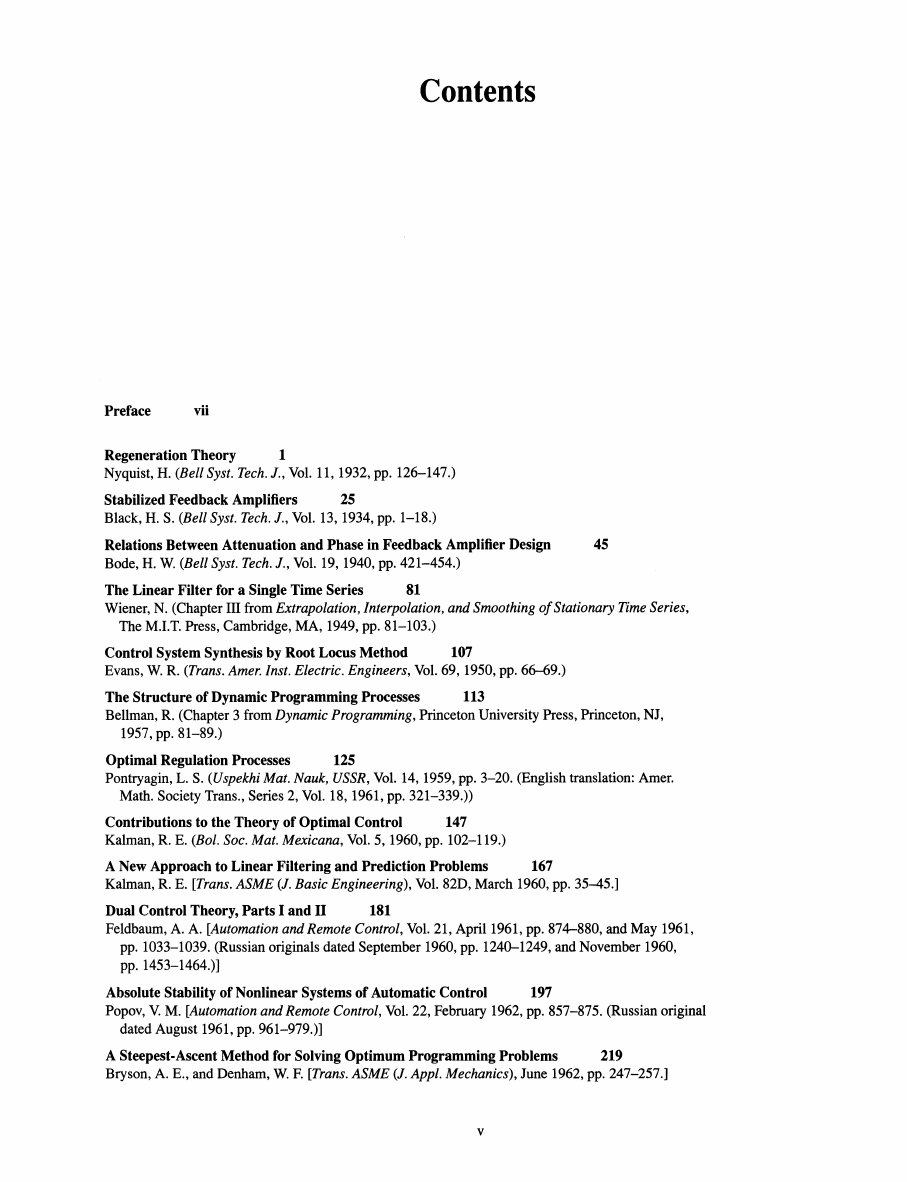
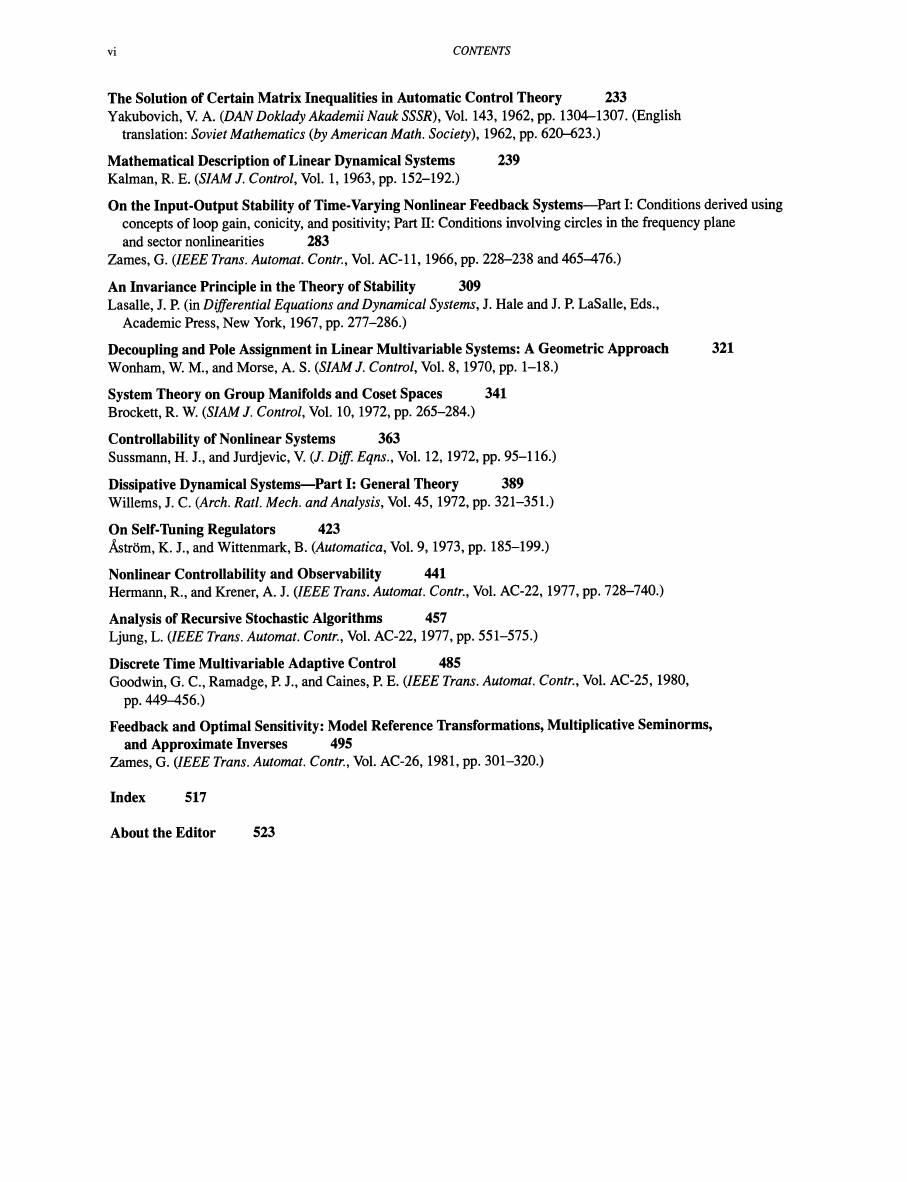
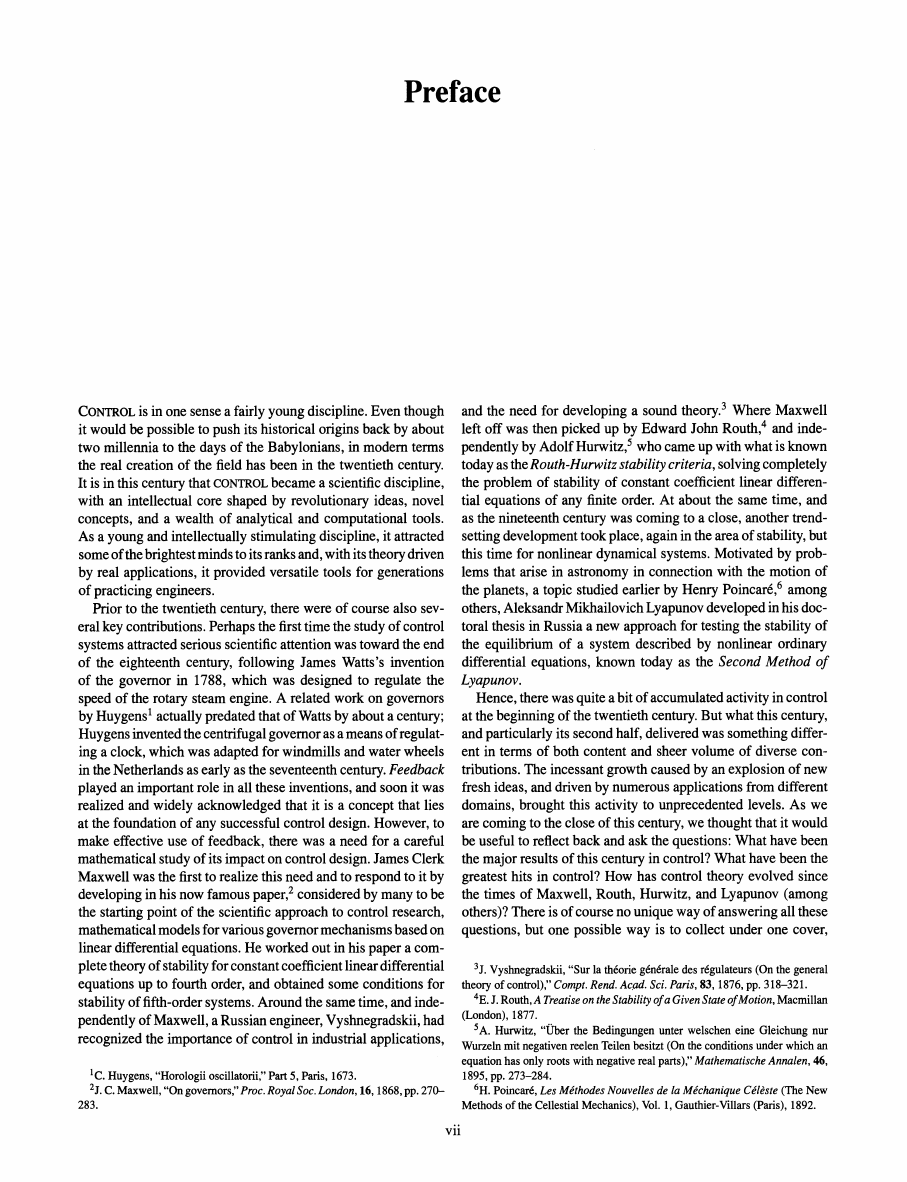
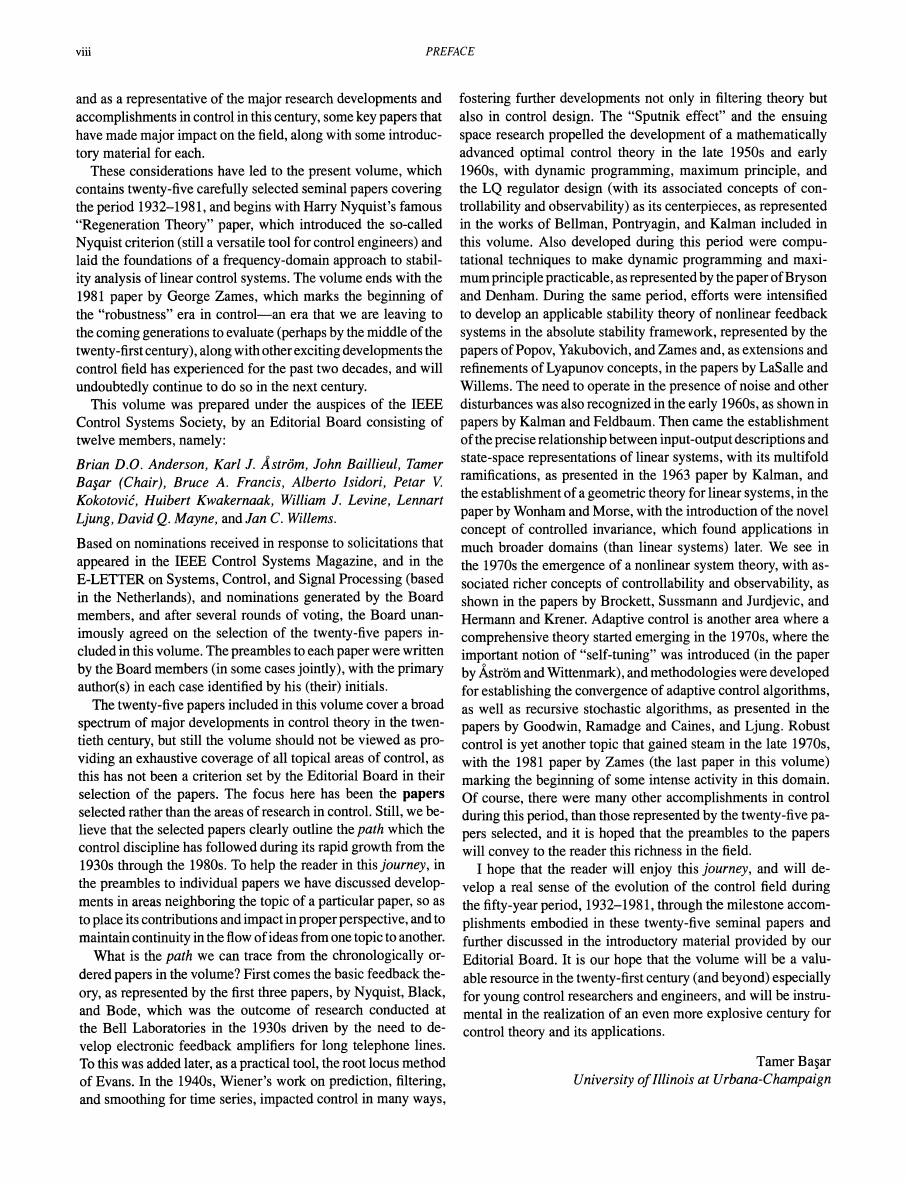








 2023年江西萍乡中考道德与法治真题及答案.doc
2023年江西萍乡中考道德与法治真题及答案.doc 2012年重庆南川中考生物真题及答案.doc
2012年重庆南川中考生物真题及答案.doc 2013年江西师范大学地理学综合及文艺理论基础考研真题.doc
2013年江西师范大学地理学综合及文艺理论基础考研真题.doc 2020年四川甘孜小升初语文真题及答案I卷.doc
2020年四川甘孜小升初语文真题及答案I卷.doc 2020年注册岩土工程师专业基础考试真题及答案.doc
2020年注册岩土工程师专业基础考试真题及答案.doc 2023-2024学年福建省厦门市九年级上学期数学月考试题及答案.doc
2023-2024学年福建省厦门市九年级上学期数学月考试题及答案.doc 2021-2022学年辽宁省沈阳市大东区九年级上学期语文期末试题及答案.doc
2021-2022学年辽宁省沈阳市大东区九年级上学期语文期末试题及答案.doc 2022-2023学年北京东城区初三第一学期物理期末试卷及答案.doc
2022-2023学年北京东城区初三第一学期物理期末试卷及答案.doc 2018上半年江西教师资格初中地理学科知识与教学能力真题及答案.doc
2018上半年江西教师资格初中地理学科知识与教学能力真题及答案.doc 2012年河北国家公务员申论考试真题及答案-省级.doc
2012年河北国家公务员申论考试真题及答案-省级.doc 2020-2021学年江苏省扬州市江都区邵樊片九年级上学期数学第一次质量检测试题及答案.doc
2020-2021学年江苏省扬州市江都区邵樊片九年级上学期数学第一次质量检测试题及答案.doc 2022下半年黑龙江教师资格证中学综合素质真题及答案.doc
2022下半年黑龙江教师资格证中学综合素质真题及答案.doc